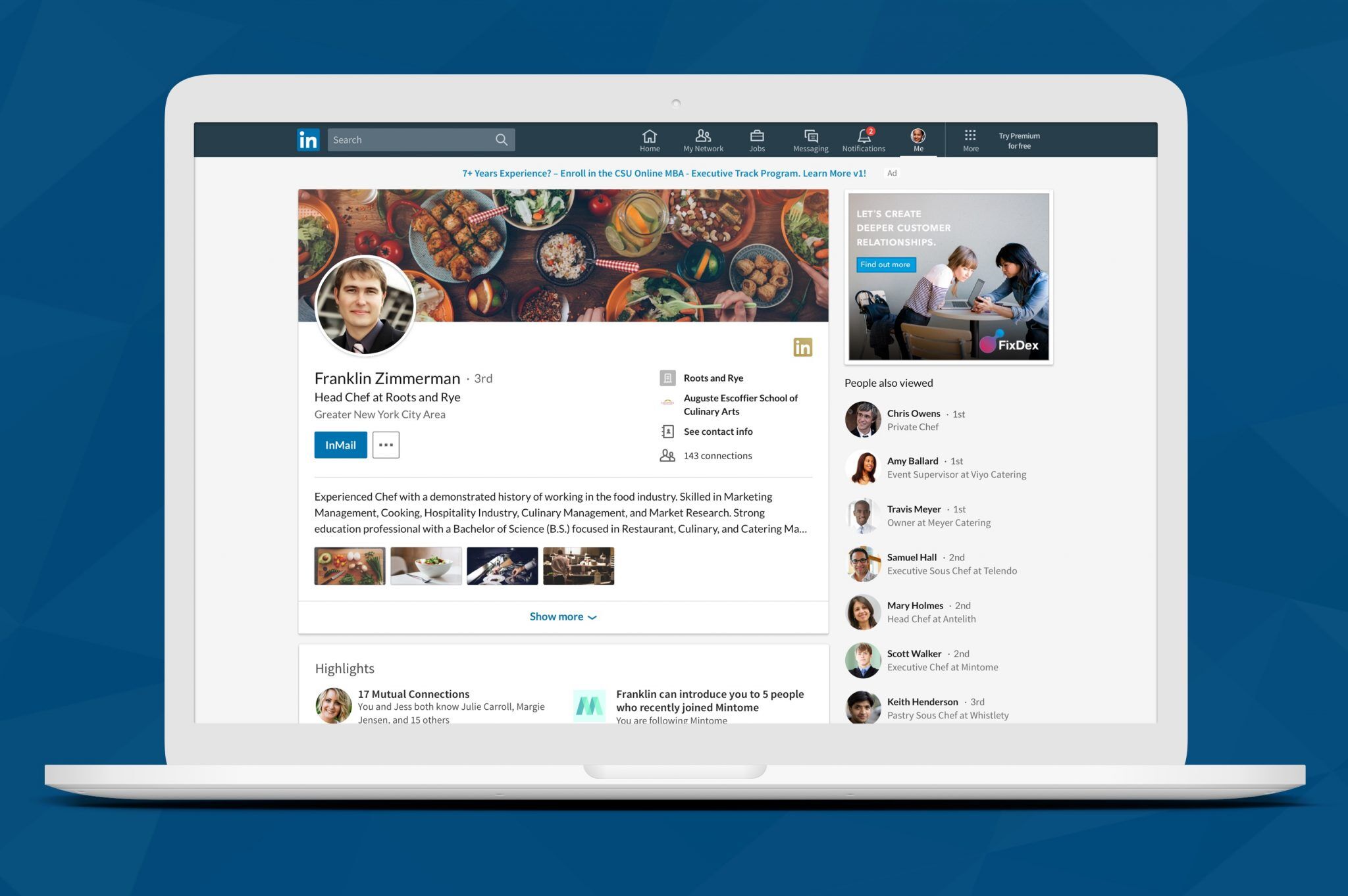One of the biggest misconceptions I hear from clients is “I don’t need to be on LinkedIn, I’m not looking for a job”.
Well. I’ll show you one stat to convince you that you definitely should be on Linkedin:
66% of professionals state that they would be more likely to recommend a company or a brand if they followed one of the company executives on Linkedin (source).
So now that we’re past that debate, the next logical question is “How should I use LinkedIn?”.
There’s no hard and fast rule. Everyone should use LinkedIn in the way that makes the most sense for their industry and their personal brand, but over the course of this post we’re hoping to help you figure out how to get started on your journey of LinkedIn mastery.
LinkedIn is one of the strongest tools available for businesses, no matter whether you’re looking for a job, looking for employees, trying to grow your personal network or looking to generate leads.
One last caveat before we dig in: This post is not here to help salespeople use LinkedIn for cold prospecting. LinkedIn can be extremely effective for sales, but that’s not my area of expertise, so I won’t venture into it.
The concepts outlined here, however, apply for CEOs, for business leaders, for employers and for potential recruits. They apply to anyone who’s out there to build a personal brand, no matter whether it’s for themselves or for their business.

Know Your Audience
It’s critical to get on the LinkedIn train as quickly as possible, but don’t just rush into posting. Start with some careful following of people in your industry.
Once you’ve followed them, monitor their posting habits carefully, and be sure to take a note of what their audiences are reacting to.
If you can, also spend some time on the profiles of some people who you feel would match your ideal audience, too. Look at their activity. See the kind of content they’re engaging with, and see which of their posts are doing well, too.
This should give you a much better idea of who you should be talking to, what drives them, what they like, and what they don’t react to.
If I’m very certain about my audience, I also use a little trick – I pretend that I have an audience of one. If I’m writing a post for a very specific subset of my audience I will actually think of someone in particular, and write my posts as if they’re the only person who I want to influence with my post.
Friendly tip: Write out your target audience persona in a document and keep it on hand when writing a post, take a look, choose who you’re writing for and let the magic happen.

Who do you want to be on LinkedIn?
We’re all multifaceted individuals, and while we would never recommend trying to be someone who you aren’t, you should be selective about which sides of your persona to share on LinkedIn.
At face value this might sound nefarious, however we don’t mean it in that way.
The first rule of LinkedIn is Authenticity, and we stick by that claim.
But curation does not preclude authenticity. I’m interested in a hundred things. God knows I’m interested in too many. But I leave most of my interests off LinkedIn, simply because LinkedIn is not a personal interest network.
I never talk about travel, food, hiking, running or music on LinkedIn, even though they’re my biggest passions in life. I might use them to highlight a professional point, however that’s where it stops.
But that’s just me. I follow some people on LinkedIn who have made exercise part of their LinkedIn persona, and it’s fine. As long as you think about it and make a conscious choice and stick to it, there is no right or wrong selection.
In my case, for example, I’ll write about marketing, about business leadership, about working conditions and employees’ wellbeing, about company culture and about my personal/professional life.
Friendly Tip: If you want this to be easier, write down your topics in a document and browse through them any time you’re stuck for a post. This list is not set in stone, so feel free to update it at any point.

Know your Mission
LinkedIn can be what you want it to be. You can find it to be absolutely useless, and you can derive extreme value from it, but that lies solely up to you, and up to how clear you are on your mission from LinkedIn.
You can’t be everything to everyone, and the quicker you learn that, the better. Some people will post exclusively to entertain, others will choose to use LinkedIn to teach about a subject that’s really close to their heart, while some others still will use LinkedIn to show their expertise in a subject, to become thought leaders in their field.
Our bias here is firmly towards the last option, most of the advice in this post is geared towards establishing your personal brand as a thought leader, but whatever your mission is, we’ll stick by our advice to choose your mission and to be clear about it.
Having a mission will help guide your behaviour on the platform, just like choosing your audience and choosing which areas of yourself you want to focus on.
Friendly Tip: Not having a mission can make your posts feel disjointed, and it will confuse people who are trying to figure you out. If in doubt, we’d recommend going for thought leadership because it’s a route that should work for anyone who has something to contribute.

Read and engage
Some people head to LinkedIn with one simple mission. To use it as a loudspeaker. They think that the only use for LinkedIn is to go out and amplify their voice.
Well. No.
To build a network you need two-way traffic. You have to take the time to read (or watch) other people’s content and to engage with it meaningfully.
Do this with intent. Don’t just like random things. Take the time to find content from people (and brands) that you find interesting, leave valuable comments when you have something to add.
There are many advantages. You get to consume content that you enjoy, teaching you more about what works and what doesn’t work on the platform. By engaging with other people’s content meaningfully you also increase your reach and, more importantly, you start building (or continue nurturing) relationships with the people who you’re engaging with.
The number of people who leave engaging comments is much smaller than the number of people who simply browse LinkedIn, so this is a great way to get noticed, especially if you engage with posts that have a lower reach.
Friendly Tip: Do not engage and comment on posts indiscriminately. You’ll be caught out, and you’ll be flagged as a spammer. Only leave a comment on a post if you have something valuable to say.

How to Fix your LinkedIn Profile
Your LinkedIn profile is a version of your CV/Resume that everyone has access to, so you should spend some time looking at it and planning out what you want potential connections to think of you when they land on it.
First of all ensure that you have a recent, professional profile picture. One that really emphasises who you are and what people can expect from you once they get to know you. Don’t use a crop from a group photo or a photo of you from your last summer vacation, sunglasses on your face and two margaritas in your hand.
There’s nothing wrong with going on vacation, or with margaritas, but it’s not the right place to highlight your drinking habit (unless you’re applying for jobs with a drinks company).
Next, make sure to write a great “About” section. Tell people who land on your profile what to expect from you, why you should be trusted for the areas you want to be trusted on, what drives you and what your areas of expertise are.
Go through all your roles and your education and fill in the sections with as much detail as you possibly can, highlighting achievements and accomplishments, and articulating what each of your experiences has taught you.
Choose a featured post that highlights your greatest achievement(s) and if you have any notable projects that you can boast about, make sure to include them.
Last, but definitely not least, take a look at your headline and optimise this to help people understand why they should be interested in you. The headline is the only thing that pops up when people view your profile at a glance (like when they hover over your name when you comment on a post), so this should be compelling enough to draw them in further.
Friendly Tip: If you’re stuck here, this would be one of the places I’d choose to spend some money on and bring in a professional to help you out. A great profile goes a long way in establishing whether you’re trustworthy or not.

Be consistent
My final piece of advice today is to be consistent. Your success or failure of your LinkedIn presence is contingent on consistency.
Be consistent with your presence. Make it a point to log in daily, and make it a point to spend some time interacting with content, as suggested above.
Be consistent with your content – don’t post three times in a day and then abandon the platform for another 3 weeks, only to log in again and post another sporadic burst.
Be consistent with your engagement with others, engage with content that makes sense to you, and engage with it on a regular basis.
Be consistent with growing your network. Add people who make sense to you, and accept connections who you think might be valuable, but don’t just accept anyone.
Friendly tip: Find a time that works well for you and create a habit of logging in to LinkedIn. If you feel like you don’t have the time for it, replace one of your other social media habits with it. It’s easy enough.

And in the end…
LinkedIn is powerful. If used correctly it can transform your career and it can catapult your business to new heights. Don’t abuse it, and don’t abandon it. Do it just right, and you’ll reap the rewards for years to come.
If you feel like you don’t have the time to handle it regularly enough, talk to us. We can provide you with more tips and tricks we use to keep our LinkedIn constantly updated. If you just want it off your plate, we also offer a concierge service for LinkedIn for busy executives.




